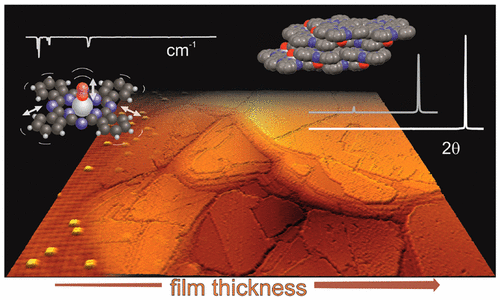当前位置:
X-MOL 学术
›
J. Phys. Chem. C
›
论文详情
Our official English website, www.x-mol.net, welcomes your
feedback! (Note: you will need to create a separate account there.)
Evolution of TiOPc Films on Au(111): From Seed Layer to Crystalline Multilayers
The Journal of Physical Chemistry C ( IF 3.3 ) Pub Date : 2020-06-11 , DOI: 10.1021/acs.jpcc.0c03244 F. Widdascheck 1 , M. Kothe 1 , S. Thussing 1 , P. Jakob 1 , G. Witte 1
The Journal of Physical Chemistry C ( IF 3.3 ) Pub Date : 2020-06-11 , DOI: 10.1021/acs.jpcc.0c03244 F. Widdascheck 1 , M. Kothe 1 , S. Thussing 1 , P. Jakob 1 , G. Witte 1
Affiliation

|
Since optoelectronic properties of organic semiconductor films are closely linked to their structural properties (such as molecular orientation, crystalline phase and orientation, degree of crystallinity, etc.), a microscopic understanding of heterogrowth behavior is of utmost importance to control and improve such films for device applications. For the case of titanyl phthalocyanine (TiOPc), a widely used molecular semiconductor for organic optoelectronics, the initial film growth on metal substrates has already been studied extensively by means of scanning tunneling microscopy (STM), whereas discussion of the molecular arrangement in seed layers and the subsequent film growth includes some controversy. Here, we combined scanning probe microscopy [(STM) and atomic force microscopy (AFM)] with X-ray diffraction (XRD) and reflection absorption infrared spectroscopy (RAIRS) to shed some light on this debate and analyzed the evolution of TiOPc films on Au(111) ranging from initial seed layers up to thick multilayers (50 nm) aiming at preparing long-range ordered films and identifying their structure. We demonstrate that long-range ordered films are formed at 450 K, where molecules reveal an all oxygen-up orientation in the monolayer and an oxygen-down geometry in the second layer, while ruling out phases comprising inclined molecules based on corresponding RAIRS data. Such bilayers are stabilized by the oppositely oriented axial dipole moments forming stable building blocks that cause a subsequent bilayer-wise growth. These yield very smooth multilayers which exclusively crystallize in the phase I polymorph and hence parallel the growth scenario observed before for Ag(111) substrates. Films prepared at room temperature exhibit reduced ordering and the appearance of several metastable phases, none of them involving inclined molecules. The present study emphasizes the importance of using complementary techniques to obtain a comprehensive picture of organic film growth, while an analysis based solely on imaging techniques can sometimes lead to incorrect conclusions.
中文翻译:

Au(111)上TiOPc薄膜的演变:从种子层到结晶多层
由于有机半导体薄膜的光电特性与其结构特性(例如分子取向,晶相和取向,结晶度等)紧密相关,因此,对于异质生长行为的微观理解对于控制和改进此类薄膜至关重要。设备应用程序。就钛氧基酞菁(TiOPc)这种广泛用于有机光电子的分子半导体而言,已经通过扫描隧道显微镜(STM)广泛研究了金属基板上的初始膜生长,同时讨论了种子层中的分子排列随后的电影发展也引起了一些争议。这里,我们将扫描探针显微镜[(STM)和原子力显微镜(AFM)]与X射线衍射(XRD)和反射吸收红外光谱(RAIRS)相结合,为这一争论提供了一些信息,并分析了Au上TiOPc膜的演变111)从最初的种子层到厚的多层膜(50 nm),目的在于制备长距离有序薄膜并确定其结构。我们证明了在450 K处形成的长程有序薄膜,其中分子在单层中显示了所有的氧向上取向,在第二层中显示了氧向下的几何形状,同时根据相应的RAIRS数据排除了包含倾斜分子的相。这样的双层通过形成相反方向的轴向偶极矩而稳定,从而形成了稳定的结构单元,从而导致随后的双层生长。这些产生非常光滑的多层,其仅在I相多晶型物中结晶,因此平行于之前对于Ag(111)衬底观察到的生长情况。在室温下制备的膜表现出降低的有序性和几种亚稳态相的出现,它们都不涉及倾斜分子。本研究强调使用互补技术获得有机膜生长的全面情况的重要性,而仅基于成像技术的分析有时会得出错误的结论。
更新日期:2020-07-09
中文翻译:

Au(111)上TiOPc薄膜的演变:从种子层到结晶多层
由于有机半导体薄膜的光电特性与其结构特性(例如分子取向,晶相和取向,结晶度等)紧密相关,因此,对于异质生长行为的微观理解对于控制和改进此类薄膜至关重要。设备应用程序。就钛氧基酞菁(TiOPc)这种广泛用于有机光电子的分子半导体而言,已经通过扫描隧道显微镜(STM)广泛研究了金属基板上的初始膜生长,同时讨论了种子层中的分子排列随后的电影发展也引起了一些争议。这里,我们将扫描探针显微镜[(STM)和原子力显微镜(AFM)]与X射线衍射(XRD)和反射吸收红外光谱(RAIRS)相结合,为这一争论提供了一些信息,并分析了Au上TiOPc膜的演变111)从最初的种子层到厚的多层膜(50 nm),目的在于制备长距离有序薄膜并确定其结构。我们证明了在450 K处形成的长程有序薄膜,其中分子在单层中显示了所有的氧向上取向,在第二层中显示了氧向下的几何形状,同时根据相应的RAIRS数据排除了包含倾斜分子的相。这样的双层通过形成相反方向的轴向偶极矩而稳定,从而形成了稳定的结构单元,从而导致随后的双层生长。这些产生非常光滑的多层,其仅在I相多晶型物中结晶,因此平行于之前对于Ag(111)衬底观察到的生长情况。在室温下制备的膜表现出降低的有序性和几种亚稳态相的出现,它们都不涉及倾斜分子。本研究强调使用互补技术获得有机膜生长的全面情况的重要性,而仅基于成像技术的分析有时会得出错误的结论。









































 京公网安备 11010802027423号
京公网安备 11010802027423号